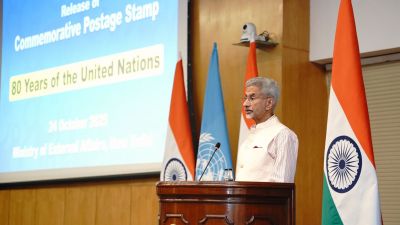London’s New Body Shop
So, what do you want after death — being consigned to a funeral pyre on the ghats of the Ganges, being buried in a grave or, standing s...

So, what do you want after death — being consigned to a funeral pyre on the ghats of the Ganges, being buried in a grave or, standing skinless, exposing all your organs, in a museum amidst thousands of curious onlookers? The last option is yours if you agree to preserve your body in plastic fluid and transform it into an object of art. Your brain, heart and liver may also be sliced and dissected to enhance the knowledge of young school kids. Keen on the idea? Make a wish and donate your body to Prof Gunther von Hagens, Institute for Plastination, Heidelberg University, Germany.
The 57-year-old professor has devoted his life to the task of skinning human bodies and rearranging organs, muscles and tissues to make an extraordinary exhibition of corpses. One has to spend hours in the queue to visit Von Hagen’s extraordinary exhibition ‘Body Worlds: The Anatomical Exhibition of Real Human Bodies’. The exhibition is being held at Atlantis Gallery at the top end of London’s Bangla town, Brick Lane.
One of the exhibits, the astonishing ‘Organ Man’ has been created by dissecting a human body into two halves and expanding it sideways so that each and every organ can be clearly viewed. One can also see the longitudinally exploded view of the human body, a corpse stretched up to show a cascading arrangement of human organs.
What makes ‘Body World’ unique is the imaginative display of human endeavours and its impact on the human body. One can see what happens to the organs of a pole vaulter when he reaches the bar, how a sprinter, a basketball player and a horse rider stretch and expand their limbs and muscles. Von Hagens has conjured up the beauty of posture, the dynamics of momentum and a very imaginative re-arrangement of human organs.
That’s where biology and anatomy make way for extraordinary art, not seen since the days of Leonardo da Vinci. ‘‘I see myself in the tradition of artists and scientists of the Renaissance, like Leonardo and Vesalius and Durer,’’ explains Von Hagens. ‘‘They embodied the last time when art and anatomical science were indistinct and beauty beneath the skin was celebrated,’’ he says.
Neither is the scientist community pleased with Von Hagens. The German Association of Anatomists described the show as ‘‘perverse’’ and ‘‘a puppet show.’’ Church leaders in the past have condemned it as ‘‘tasteless, immoral, and voyeuristic.’’ One of them described the exhibition as an ‘‘illegal cemetery’’ and many wanted to put flowers to please the disturbed souls of dead men.
Women’s groups find it particularly offensive because the exhibits included a pregnant woman with a womb cut up to show a full grown baby inside it. In fact, after its first show in Mannheim in Germany in 1997, there was a heated debate in the German Parliament, where many MPs condemned ‘Body Worlds’ as ‘‘degrading to human dignity.’’
It was anatomist Andre Vesalius (1514-1564) who revolutionised knowledge of the interior of the human body. He is considered the father of the modern scientific anatomy. He worked out how the bones fitted together. In one respect, he left Von Hagens well behind. He was the first to make an exhibition of the interior of the human body. He used to conduct the ‘Anatomical Theatre’ by performing open autopsies amidst hundreds of onlookers. But it was the famous 19th century Russian anatomist Nikolas Pirogoff who succeeded in slicing through the human body. He made 213 drawings to offer a comprehensive picture of the body’s interior, including one of a pregnant woman.
Prof von Hagens has been accused of illegally importing dead bodies from Russia. He denies the charge and runs an elaborate programme of body donation. And there is no dearth of donors. Meet Susanne Wissler of Mannheim, Germany: ‘‘Knowing that that my body has been disposed of sensibly, in this way, is a nice thought, nicer than the thought of rotting away and being eaten by worms.’’ Another German, Volke Rosenkranz, wrote to Von Hagens, ‘‘It’s got to be more fun than being buried. And it’s cheaper.’’
Despite criticism, human interest has not diminished in Von Hagens’ seemingly terrible occupation of cutting and chopping human bodies. A lot of us would not mind winking at a roadside animal carcass being shredded and devoured by vultures. More than 10 million people have already visited the exhibition on its tours through Germany, Japan, Austria, Switzerland and Belgium. In London alone half a million visitors, including 300 school groups, have seen the exhibition.





- 01
- 02
- 03
- 04
- 05


























